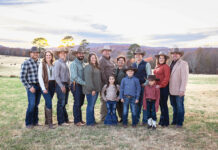 Gary and Jewell Proctor of Lincoln, Ark., were both raised on farms and met while they worked at the Baldwin Piano factory in Fayetteville, Ark.
Gary and Jewell Proctor of Lincoln, Ark., were both raised on farms and met while they worked at the Baldwin Piano factory in Fayetteville, Ark.
Currently the Proctors own 400 acres and lease an additional 800 with 700 momma cows and 25 bulls. They own some of the cattle and some in partnership with their son, Daren, who is also a full-time farmer. Most of their momma cows are Braford and Tiger Stripe which they breed to Charolais bulls. The Brahma influenced cows provide heat tolerance, bigger calves, richer though not necessarily abundant milk, good protective instincts, and reproductive longevity. The Proctors also have a few black mommas which they breed to black Simmentals in order to get a bigger calf.
The Proctors sell one or two semi loads of calves at the Stillwell, Okla., sale barn at a time but advertise about two weeks before the sale, which results in repeat buyers. They have built a reputation for high quality, well cared for animals. The 500-pound spring calves are sold immediately after weaning and after being vaccinated, castrated and dehorned. The fall calves are sold at 800 pounds with an added treatment of shots and deworming. Jewell said, “Buyers will pay more if they know the spring calves are weaned and have had their shots and the fall calves have had two rounds of shots.” Then Gary added, “The key to good calves is good forage, and providing high-quality forage is one of the main focuses of my business because 80 percent of my income is derived from cattle.”
The severe drought of the last three years has taken a severe toll on the Proctor’s land resulting in a loss of much of their permanent grass, which was predominantly Fescue.
Gary believes that farmers need to be knowledgeable about which government programs are applicable to their operations and then take advantage of the programs even though that means personally going to the local USDA facility to sign up. One program is cost-share, which means paying the full cost up front with reimbursement coming later. In the case of reseeding, a government inspector comes after germination to inspect the fields before reimbursement checks are issued. Because of the drought, the government offered an 80-20 cost-share program to help farmers reseed their land. The first year the government reimbursed seeding both Rye and Ladino legumes while the second year they reimbursed only the legumes. Nonetheless, the savings for the Proctors was significant.
Gary said, “Good field care, whether hay ground or pastureland, means more pounds of forage per acre resulting in more pounds of beef per acre.” Gary sets aside 400 acres of land as hay ground but will turn the animals on the hay ground after the first frost if good forage is available. Gary fertilizes with chicken litter and then top dresses with commercial ammonia nitrogen (34-0-0) testing his soil every five years. He also sprays for weeds with spot spraying as needed. The last two years he has hired neighbor Warren Napier to seed turnips in a wheat field. Gary said, “The calves aren’t ready to eat turnips until they are about a year old, but then they will eat the tops, pull up the turnips, and eat them as well. Turnips are economical and easy to drill in with the wheat and my calves are gaining more weight so I plan on continuing to use a wheat/turnip field with my fall calves.”
Gary and Jewell have a 6-year-old grandson named Denim will hopefully be the third generation to work on the Proctor farm.







